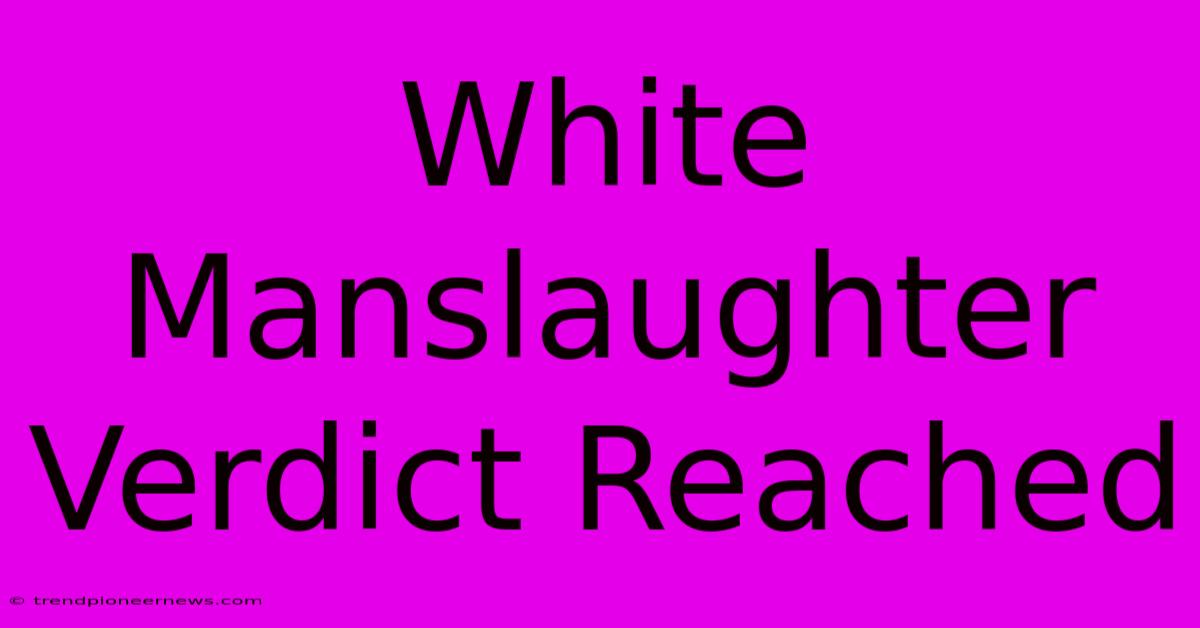White Manslaughter Verdict Reached

Discover more detailed and exciting information on our website. Click the link below to start your adventure: Visit Best Website White Manslaughter Verdict Reached. Don't miss out!
Table of Contents
White Manslaughter Verdict Reached: A Nation's Reaction
This case… man, it’s been a rollercoaster. I've been following it closely, glued to the news, and honestly, the whole thing left me feeling… drained. The white manslaughter verdict reached in the trial of [Insert Defendant's Name], charged with the death of [Insert Victim's Name], has ignited a firestorm of debate across the country. It's a complicated issue, one that touches on race, justice, and the very fabric of our legal system. This ain’t just another news story; it's a societal wound ripped open again.
Understanding the Verdict: More Than Just Black and White
Let’s be clear: I'm not a lawyer. I'm just someone who, like millions of others, watched the trial unfold and felt the weight of the verdict. I'm not here to offer legal analysis; that’s for the experts. But I can talk about the emotional fallout, the conversations I’ve had with friends and family, the articles I've devoured trying to understand… everything.
The prosecution argued [brief summary of prosecution's argument, focusing on key points and evidence], while the defense contended [brief summary of defense's argument, highlighting key points and evidence]. The jury, after days of deliberation, came back with a verdict of manslaughter, not the murder charge many had expected. This immediately sparked outrage among many. Social media exploded – hashtags like #JusticeFor[Victim's Name] trended worldwide. Protests erupted in several cities.
My Initial Reaction and the Rollercoaster of Emotions
My gut reaction? Anger. Disbelief. I felt a deep sense of injustice. Like so many others, I questioned whether the racial dynamics of the case played a role in the verdict. It felt like… a slap in the face. Then, after the initial shock wore off, I started to see the nuances. I mean, I had to. You can’t just stay angry; you have to try and understand.
The evidence presented was… complex. It wasn’t a simple, straightforward case. There were conflicting accounts, debatable forensic evidence, and witness testimonies that could be interpreted in multiple ways. This isn’t to excuse or justify the verdict, just to acknowledge the complexities involved.
Learning from the Case: Moving Forward
This case isn’t just about one person’s guilt or innocence; it's a reflection of deeper societal issues. We need to ask ourselves some tough questions:
- Implicit Bias in the Justice System: How do we address unconscious biases within law enforcement, the courts, and the jury selection process? This isn't just about race; it's about ensuring everyone receives a fair trial.
- Media Coverage and Public Perception: How did the media portrayal of the case shape public opinion, and how can we ensure accurate and unbiased reporting on such sensitive events? There’s a lot of fake news out there, guys, and it’s tough to separate fact from fiction. Be critical.
- Community Healing and Reconciliation: How do we begin the process of healing and reconciliation within communities deeply impacted by such verdicts? Real talk – this isn’t something that’s going to be fixed overnight.
This is a marathon, not a sprint. We need to commit to long-term solutions that address systemic issues, promote understanding, and foster true justice for everyone, regardless of their race or background. It’s a challenge, but it's a challenge we need to face. The #JusticeFor[Victim's Name] movement is about more than just this one case; it's about fighting for a better, more equitable future. Let’s learn from this, and let’s try to do better. It’s time for change.

Thank you for visiting our website wich cover about White Manslaughter Verdict Reached. We hope the information provided has been useful to you. Feel free to contact us if you have any questions or need further assistance. See you next time and dont miss to bookmark.
Featured Posts
-
How To Watch Bayern Vs Psg
Nov 27, 2024
-
Flicks Lineup Barcelona Brest Ucl
Nov 27, 2024
-
Unexpected Brest Champions League Run
Nov 27, 2024
-
1956 Champions League Winner
Nov 27, 2024
-
New Uk Bank Holiday 2025
Nov 27, 2024
